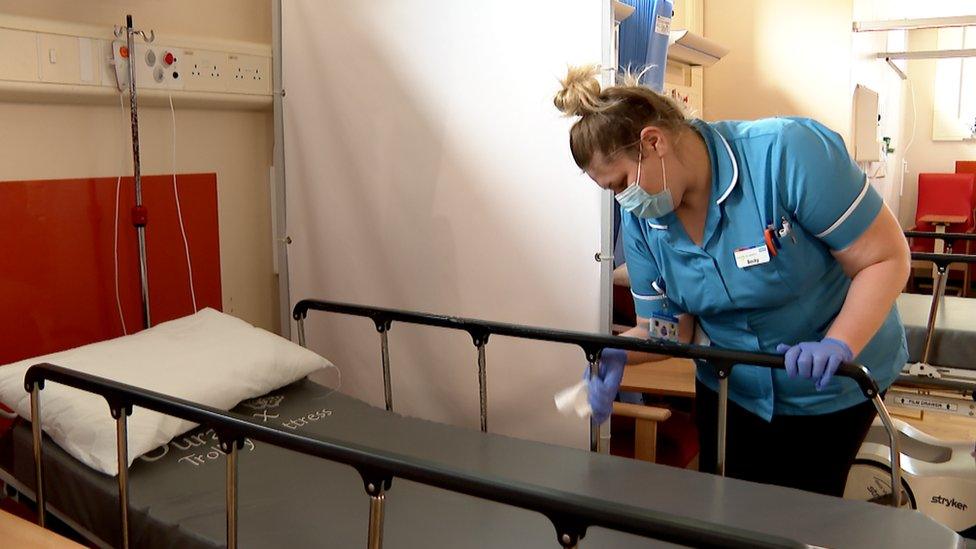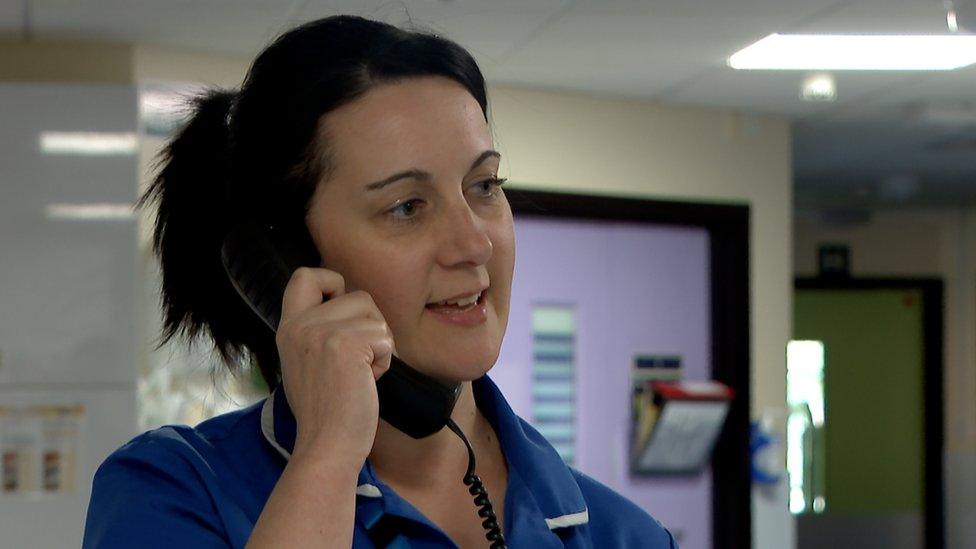NHS struggles to get back to a new 'normal'
- Published

There will be a new normal for the NHS - but it will be very different from the one with which patients were familiar before the coronavirus crisis.
That's what health leaders are predicting as hospitals start reintroducing services cancelled during the weeks of peak Covid-19 pressure.
Not only that - getting out of the current situation will be harder than going in.
There is no doubt that transforming hospitals to handle the expected surge in coronavirus patients was a major achievement.
Inside an ICU fighting Covid-19
Coronavirus and cancer: 'We don't have time to wait'
Coronavirus: Sickest patients face long recovery
Routine surgery was cancelled and tens of thousands of extra critical-care beds were created in a matter of weeks. Despite warnings that the NHS might be overwhelmed, hospitals and other services coped.
But with the recent peak now past, where does the NHS go from here? How will social distancing be observed? How much capacity will be held back in case virus infections pick up again? How quickly can the backlog of operations and treatments be cleared?
Niall Dickson, chief executive of the NHS Confederation, says tackling the backlog and the damage caused by the virus will be a "massive undertaking".
He adds that there is a long list of problems to address: "The mental health of the population, the untreated disease, the delayed operations, the undiagnosed conditions, the victims of closed screening programmes and the depressed demand from so many who have not sought help."
Non-urgent services return
Ipswich Hospital is, like others, beginning the process of reintroducing non-urgent services.
A ward which was a complex care unit for elderly patients before the pandemic, was converted into a "red ward" for Covid-19 patients, including those receiving end-of-life care.
Now it is being deep-cleaned and is ready to go back to being a "green ward" for non-Covid-19 patients.

Social distancing will reduce patient capacity
But because of social distancing, the ward capacity will be reduced and Perspex screens will separate the beds.
If there is a second peak in the virus, it may have to go back to being a "red ward".
In A&E, patient numbers are picking up a bit after falling away dramatically during April.
The department is being reconfigured to avoid crowding and keep people at a safe distance from one another. This could involve a one-way system for patients arriving and leaving.
Ipswich is part of the East Suffolk and North Essex NHS Trust whose chief executive is Nick Hulme.
He is trying to prepare patient expectations while encouraging them not to stay away and put their health at risk: "We are doing it very carefully. I think it would be wrong to start a lot of services and then realise we had to close them down again because we didn't have the capacity, the staff or the PPE.
"But I think there is also an important message that we are open for business, so making sure people who are worried about their health still contact their GP, or still come in to A&E."
Staffing could be problematic. Frontline doctors, nurses and other health professionals have worked in stressful conditions caring for Covid-19 patients.
Their welfare must be prioritised while ensuring hospital services can be expanded, and keeping open the possibility of another spike in virus cases.
Unravelling takes time
Dr Lauren Hoare is a consultant at the hospital and clinical director for its emergency assessment unit: "When we put in the emergency provisions and the emergency rotas to start with when corona virus was at its peak, we switched on a lot of buttons and changed things very quickly.
"Sometimes unravelling that and reversing back into normal practice is much harder and certainly takes quite a lot of organisation."

Alternatives to face-to-face consultations will be needed
Virtual consultations via video link where appropriate during the Covid-19 crisis have proved popular with doctors and patients. These seem set to take an increasing share of outpatient appointments.
GP practices report moving from around 20% of patient contacts by phone to about 75%.
Face-to-face appointments may pick up but few expect them to stay above half of an overall GP workload.
Chris Hopson, chief executive of NHS Providers, representing trusts in England, said: "Trusts will do all they can to restart services as quickly as possible.
"They'll seek to solve every problem they encounter as they've consistently done so far. They will build on the innovations they've developed over the last two months, like the 6,000 patient consultations a day now being delivered online, compared to 200 before the crisis."
So the new climate may bring positives for the NHS.
But getting back to the usual volume of activity is some way off. The virus won't disappear quickly.
Nick Hulme says they have to assume it will be a threat for some time, and infection control will have to be rigorously observed: "Some of our planning going into some of the reconfiguration of wards isn't temporary.
"We are going to have to assume we have social distancing in some of our elective plans in place for some time. So certainly this isn't one or two years we are thinking about, it could be several years."
NHS England has sent out guidance to hospitals on bringing back routine operations and appointments.
Governments in Scotland, Wales and Northern Ireland are planning a phased reintroduction of non-urgent services.
The Scottish Government's National Clinical Director, Professor Jason Leitch, said: "I don't know what a new normal looks like but I do know that the health and care services in the UK will never be the same.
"Virtual appointments, increased shared decision-making, health and care integrated leadership and public knowledge of public health will all remain and help us."

A SIMPLE GUIDE: How do I protect myself?
IMPACT: What the virus does to the body
RECOVERY: How long does it take?
R-NUMBER: Is this the crucial number?
ENDGAME: How do we get out of this mess?


